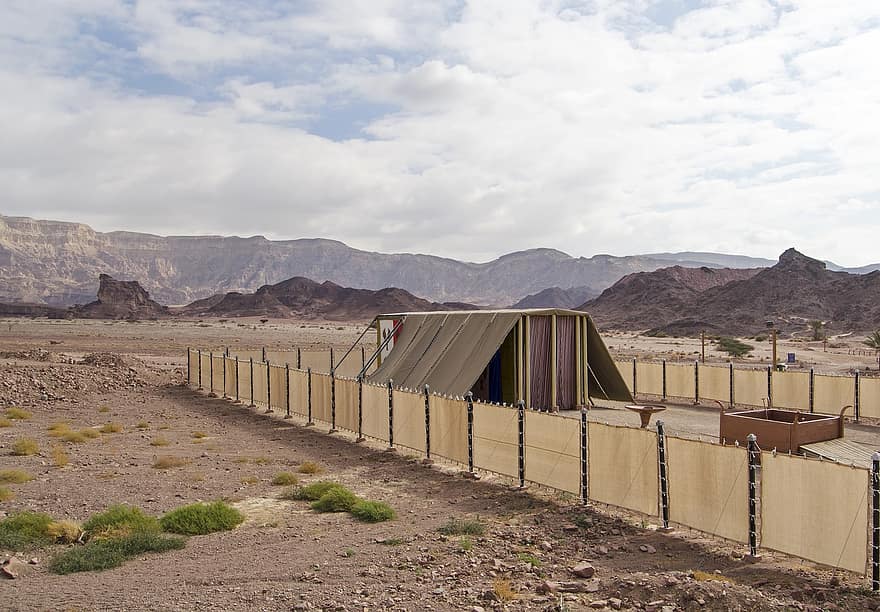
In the instructions given to Moses by God in the erection of the Tabernacle was the command to make a place for sacrifice: “You shall make an altar of earth [natural materials, including stone] for Me, and you shall sacrifice on it your burnt offerings and your peace offerings, your sheep and your oxen; in every place where I cause My name to be remembered, I will come to you and bless you” (Exodus 20:24). We understand the concept of blessings, but that of sacrifice and especially on an altar is quite unfamiliar. The “altar” (Hebrew mizbēaḥ) goes all the way back to the Garden of Eden where presumably Adam constructed the first one in history based on the example of God’s sacrifice of an animal to clothe the man and the woman (Genesis 3:21). The practice of building a sacrificial altar was obviously taught to his sons Cain and Abel (Genesis 4:3-4) and we see this as a regular act of obedience followed by Noah (Genesis 8:20), the Patriarchs (Genesis 12:7; 26:25; 35:7), Moses (Exodus 17:15), Joshua (Joshua 8:30) and the Israelites (Deuteronomy 12:1, 5-6). Throughout this period it was the king who was responsible for the construction and maintenance of legitimate altars for the God of Israel and the destruction of false altars dedicated to other gods. This practice continued until it was interrupted by the destruction of the First Temple and then resumed until the Second Temple was destroyed in AD 70 and the sacrificial system was forced to end.
The sacrificial altar was located outside in the forecourt of the Tabernacle (Exodus 27:1–8; 38:1–7) and was called “the altar of burnt offering” (hā mizbēaḥ hāʿôllāh). It was there that these regular sacrifices for atonement were offered. By contrast the altar connected with the use of incense was located inside (Exodus 30:1–10; 37:25). The sacrificial altar was constructed of acacia wood and overlaid with bronze and therefore is also referred to as the Brazen Altar. The altar was hollow, but probably filled with earth in order to dissipate the heat generated in the burning of sacrifices. Several archaeological examples exist of altars constructed with a fill of ash or earth/rubble. However, the “floor” of the altar where the wood was places was a bronze grating (Exodus 27:4). The use may have had a similar function to modern barbeque grills in letting air in to facilitate cooking.
One unique design feature of these altars was “horns” (qĕrānôt); stone projections from the corners that apparently aided in binding a living sacrifice to the altar (Psalm 118:27b; cf. Romans 12:1). The altar had to be ascended by the priests since wood was placed on the top of the altar and the sacrifice was then placed upon the wood for burning. However, God commanded that the altar could not be mounted by steps since this was the practice of pagan cultures and was associated with those priests exposing themselves as part of fertility rituals (Exodus 20:26). Fitting this description is a large circular stone Canaanite altar that was unearthed at Megiddo. To avoid anything that might such infer pagan beliefs, Israelite altars, beginning with that installed in the Tabernacle, were constructed with ramps. Also, since the Tabernacle’s altar had to be portable it was also equipped with rings through which poles could be inserted for transport.
The archaeological evidence for altars in Israel is quite extensive. One of the most impressive from the time of the Tabernacle is located on Mt. Ebal. It has been identified as the altar described in Joshua 8:30–35. Its dimensions are 27 feet x 21 feet and it is preserved to a height of 10 feet with a ramp 3.5 feet wide. It was surrounded by an inner courtyard which contained ash, animal bones and clay vessels filled with ash, and bones.
The sacrificial altar reminds us that our sin requires a substitute for forgiveness and that in God’s plan Jesus the Messiah came to fulfill this great purpose.
1 – In Exodus 20:25, Joshua 8:31, and Deuteronomy 27:5–7, where altars of stone (mizbēaḥ ʾăbānı̂m) are specified, it is forbidden to use iron tools to shape the stones. This command may reflect the idea that the unworked stone (“natural” stone) reflected the natural Creation which would be dissipated through the working with iron and reflect the work of man rather than God.
2 – See N. H. Gadegaard, “On the So-Called Burnt Offering Altar in the Old Testament,” Palestine Exploration Quarterly 110 (1978): 35–45.
3 – The problem of exposure was solved by requiring the officiating priests to wear “pants” (Exodus 28:42–43; Leviticus 6:10), something pagan priest did not do.
4 – For a retailed report on this altar see Ralph K. Hawkins, The Iron Age I Structure on Mt. Ebal: Excavations and Interpretation, BASOR Sup 6 (Winona Lake, IN: Eisenbrauns, 2012).
